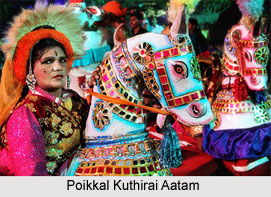 Poikkal Kuthirai Aatam Dance also known as the Dummy Horse Dance, is famous as the folk dance of Tamil Nadu.
Poikkal Kuthirai Aatam Dance also known as the Dummy Horse Dance, is famous as the folk dance of Tamil Nadu.
Poikkal Kuthirai Aatam Dance was introduced to Tamil Nadu by the Maratha kings in the medieval times. There are also references to Poikkal Kudirai Aattam Dance in early Tamil folklore.
Poikkal Kuthirai Aatam Dance is one of the eleven dances performed by Madhavi, a character in Silappadikaram. This work was written in the 2nd century and is one of the ancient epics of the Tamil language. The references to Poikkal Kuthirai Aatam Dance can also be found in the epic Tholkaapiam. In one segment, the heroine`s parents ban the marriage between their daughter and her aficionado. The hero dons a horse-like configuration made up of maple leaves and starts protesting in the streets to marry the girl. It mentions in these epics, which indicate that dance form originated many centuries ago.
There is a legend that Goddess Durga used to perform this dance. To take revenge, her enemies masquerading themselves as poisonous snakes and scorpions, and planned to bite her while dancing. Durga was aware of their plan and for self-protection she tied wood around her legs and danced. As a result of heavy dance steps made by her, her enemies died. This gave the dance the name of Marakkaladal, or Wooden Leg Dancing. Later, the dance was renamed Poikkal Kuthirai.
In Poikkal Kuthirai Aatam Dance, the dancer bears the mannequin figure of a horse`s body on his/her hips. The dummy horse is made up of light-weighted material and the cloth at the sides` swings on either side completely covering the legs of the dancer.
The folk dancer performs with wooden legs, which sound like the hooves of the horse. Here, the dancers dance along with either a sword or a whip. This folk dance needs a lot of expert movements and skills to perform.
Naiyandi Melam or Band music accompanies the dance. This is connected to the worship of Ayyanar, prevailing mainly around Thanjavur region of State, which is a city which is the headquarters of the Thanjavur District in the south Indian state of Tamil Nadu.



















